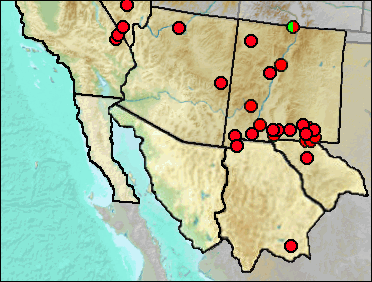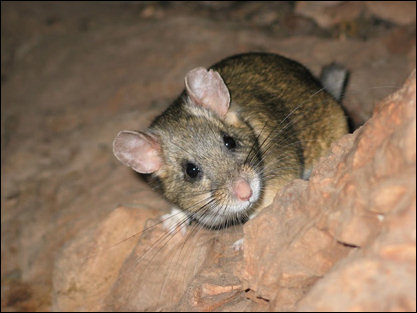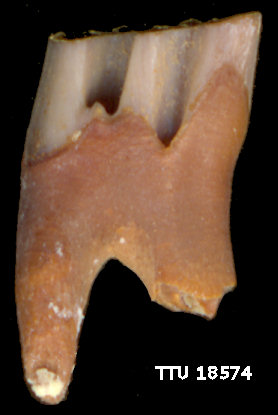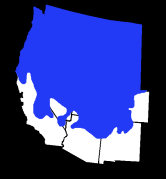Class Mammalia
Order Rodentia
Family Cricetidae
Subfamily Neotominae
Genus Neotoma

 Neotoma
cinerea is common in the Pleistocene cave faunas. Distribution within the region
today is limited to the high northern mountains plus woodland and
sagebrush habitat at lower elevations in the north. The common name
refers to the almost squirrel-like hairiness of the tail.
Neotoma
cinerea is common in the Pleistocene cave faunas. Distribution within the region
today is limited to the high northern mountains plus woodland and
sagebrush habitat at lower elevations in the north. The common name
refers to the almost squirrel-like hairiness of the tail.
Fig. 1. Neotoma cinerea. National Park Service photograph.
Distribution is almost entirely limited to rocky areas, with dens normally limited to rock crevices and caves in cliffs, talus slopes, and boulder outcrops (Smith 1997).
Large size, an anterolateral dentine tract, and frequent presence of one or more accessory cusps generally will separate the lower first molar from those of any other expectable woodrat (Fig. 2; also see Fig. 1 in the generic account). The base of the reentrants tend to be "pocketed" more than in other regional species—that is, the reentrants have their bases sunken well below the lateral walls. In extreme wear, this leaves circles of enamel revealed on the occlusal surfaces after other enamel has worn away. For the most part, dentine tracts extend farther into the enamel on other teeth also, which in conjunction with size, often will allow identification.
 Fig. 2. Lateral view of
right m1 of fossil Neotoma cinerea from Dust Cave. An accessory cusp and the
anterolateral dentine tract (brown color in this fossil) are visible, and the characteristic "pocketed"
reentrants suggested.
Fig. 2. Lateral view of
right m1 of fossil Neotoma cinerea from Dust Cave. An accessory cusp and the
anterolateral dentine tract (brown color in this fossil) are visible, and the characteristic "pocketed"
reentrants suggested.

Fig. 3. Current geographic range of the Bushy-tailed Woodrat. Adapted from Smith (1997).
Sites.
Medial Irvingtonian: SAM Cave (Rogers et al. 2000).
Rancholabrean: Anthony Gap Cave (Harris 1984b); Mescal Cave (Jefferson 1991b: cf.); Palomas Creek Cave; (Harris 1993c).
Mid Wisconsin: Pendejo Cave (Harris 2003); Screaming Neotoma Cave (Glennon 1994); U-Bar Cave (Harris 1987).
Mid/Late Wisconsin/Holocene: Jimenez Cave (Messing 1986: ?); Sierra Diablo Cave (UTEP).
Mid Wisconsin-Holocene: Shelter Cave (Harris 1984b).
Mid/Late Wisconsin: CC:5:1 (Mead et al. 2003); CC:5:5 (Mead et al. 2003); Chuar Valley (Cole and Mead 1981: cf.); Dark Canyon Cave (Tebedge 1988); Hampton Court (Harris 1993c); Pintwater Cave (Hockett 2000); Pit N&W Animal Fair (Harris 1984b).
Mid/Late Wisconsin/Holocene: Sierra Diablo Cave (UTEP).
Late Wisconsin: Algerita Blossom Cave (Harris 1993c); Animal Fair 18-20 ka (Harris 1984b); Balcony Room (UTEP); Big Manhole Cave (Harris 1993c); Bison Chamber (Harris 1989); Camel Room (Harris 1984b); Charlies Parlor (Harris 1989); Dust Cave (Harris and Hearst 2012); Harris' Pocket (Harris 1984b); Hermits Cave (Harris ID); Human Corridor (Harris 1993c); Lower Sloth Cave (Logan 1983); Muskox Cave (Logan 1981); Mystery Light Cave (this volume); Pendejo Cave (Harris 2003); Potosi Mountain (Mead and Murray 1991); Sandia Cave (Thompson and Morgan 2001); Screaming Neotoma Cave (Glennon 1994); Stalag 17 (Harris 1984b); TT II (Harris 1984b: cf.); U-Bar Cave 13-14 ka (Harris 1989; cf.); U-Bar Cave 14-15 ka (Harris 1989); U-Bar Cave 15-18 ka (Harris 1989); U-Bar Cave 18-20 ka (Harris 1989); Upper Sloth Cave (Logan and Black 1979).
Late Wisconsin/Holocene: Baldy Peak Cave (Harris 1984b); Burnet Cave (Schultz and Howard 1935); Conkling Cavern (Harris 1984b); Howell's Ridge Cave (Harris 1984b); Isleta Cave No. 1 (Harris 1984b); Isleta Cave No. 2 (Harris 1984b); Kokoweef Cave (Reynolds, Reynolds, et al. 1991); Pendejo Cave (Harris 2003); Pratt Cave (Lundelius 1979); Robledo Cave (UTEP); SAM Cave (Rogers et al. 2000); Sheep Camp Shelter (Harris 1993c).
Literature. ; Cole and Mead 1981; Glennon 1994; Harris 1984b, 1987, 1989, 1993c, 2003; Harris and Hearst 2012; Hockett 2000; Jefferson 1991b; Logan 1981, 1983; Logan and Black 1979; Lundelius 1979; Mead and Murray 1991; Mead et al. 2003; Messing 1986; Reynolds, Reynolds, et al. 1991; Rogers et al. 2000; Schultz and Howard 1935; Smith 1997; Tebedge 1988; Thompson and Morgan 2001.
Last Update: 30 May 2014